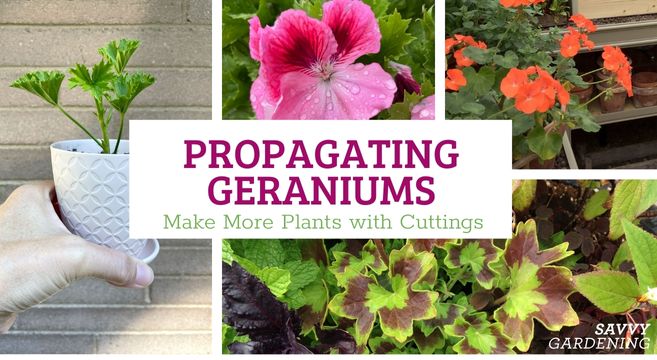This post may contain affiliate links. If you make a purchase through links on our site, we may earn a commission.
At the end of the growing season, with cold temperatures on the horizon, I often lament having to send my annuals to the compost pile. There are some annual plants that will overwinter with a bit of care. And there are others that you can also easily take cuttings from and nurture indoors. Annual geraniums (also called bedding geraniums and Pelargoniums to differentiate them from hardy, perennial geraniums) are among the plants you can propagate and keep as houseplants over the winter. If you know how to propagate geraniums, you can grow more of your favorite varieties to plant the following year in the garden, and in pots or hanging baskets.
For me, if I’m overwintering a plant in the garage, propagating a few cuttings is like a little insurance policy in case the overwintered plant doesn’t come back. It’s worth noting, however, that 100 percent success cannot be guaranteed when propagating geraniums either.
Plan to take your geranium cuttings from a healthy plant while it is still flourishing and before the weather turns cold, usually in late summer or early fall. Pelargoniums do not like frosty temperatures. Technically, there is no best time as you can take a cutting at any time of the year because annual geraniums do not go through a period of dormancy. But I don’t really think of taking cuttings until I think about potentially losing the plant!

How to propagate geraniums in potting soil
To cut and plant geranium cuttings, you will need the following:
- A sharp knife or small pruners
- Small pots (make sure there are drainage holes)
- Indoor potting soil
- Small trowel or spoon
- Filled watering can
- A healthy geranium plant
From the main plant, aka the mother plant, choose healthy shoots near the top where all the new growth is. Make sure all the leaves and the stem look healthy on the piece you’re going to take. Try to avoid taking a cutting from older branches. The cuttings do not need to be long.
Using your sharp, clean knife or small pruners (I use pocket pruners, which give me more control over the cut), make a straight cut above a leaf node. Around the base of your new stem, you can trim to the point where there is another leaf bud or node. Remove the lower leaves and rub off any stipules that remain. Stipules are raised appendages found at the base of a leaf. Place the end of your cutting into a pot filled with damp potting mix.

Some plants do well if you dip the end of the cutting in rooting hormone, but with geraniums, it can make the ends of the stem go soft. A weakened stem can lead to root rot and other fungal diseases. Apparently dipping the end of the cutting in a solution of water and vitamin C works well.
Caring for your new geranium plants
Place your newly potted plants in a warm, sunny window. Geraniums do not do well in high humidity. For this reason, you should also avoid putting them in plastic or in a tray with a plastic dome lid. However, do make sure your soil does not dry out. A heating mat can be used to help your cuttings to root more quickly.
After a few weeks, new roots will form. It will be hard to tell except for the fact that your new plant will remain healthy looking and start to produce new growth.

As your plants get bigger, you’ll need to give them a bit more water. To encourage new leaf growth and flowers, pinch out growing tips at the top of the plant. This will help the plant become bushier underneath, producing a fuller plant, rather than one with long, spindly stems.
How to propagate geraniums in water
Propagating geraniums in water is possible, but there is more of a chance of rot. And, you will have to pot them up in potting soil eventually. But if you’re in a rush, for whatever reason, take your cutting and place it in water instead.
Use the same advice listed above to choose the healthiest stems. Place the stem in a small jar or glass of fresh water, making sure there are no leaves in the water. Change out the water every few days to prevent disease.
In a few weeks, when you see that the roots have formed, you can pot up your new geranium in a container filled with fresh potting soil using the aforementioned instructions.
How to plant propagated geraniums in spring
Once spring arrives, you may want to bring your healthy little geranium houseplants outside. But don’t simply bring the pots out and forget about the. When the weather warms up, and all risk of frost has passed, you’ll want to get your geranium plants used to the outdoor temperatures. Harden them off, just as you would with your vegetable seedlings.

Once your plants are accustomed to the outdoors, you can transplant your new geraniums. Add them to container arrangements, hanging baskets, or a special spot in the garden.
More plant propagation articles
- Learn to propagate sedum
- Propagating ferns from spores and mother plants
- How to divide Pilea peperomioides
- What to do with plantlets from a mother of thousands plant
Pin to your Plant Propagation board!




Leave a Reply